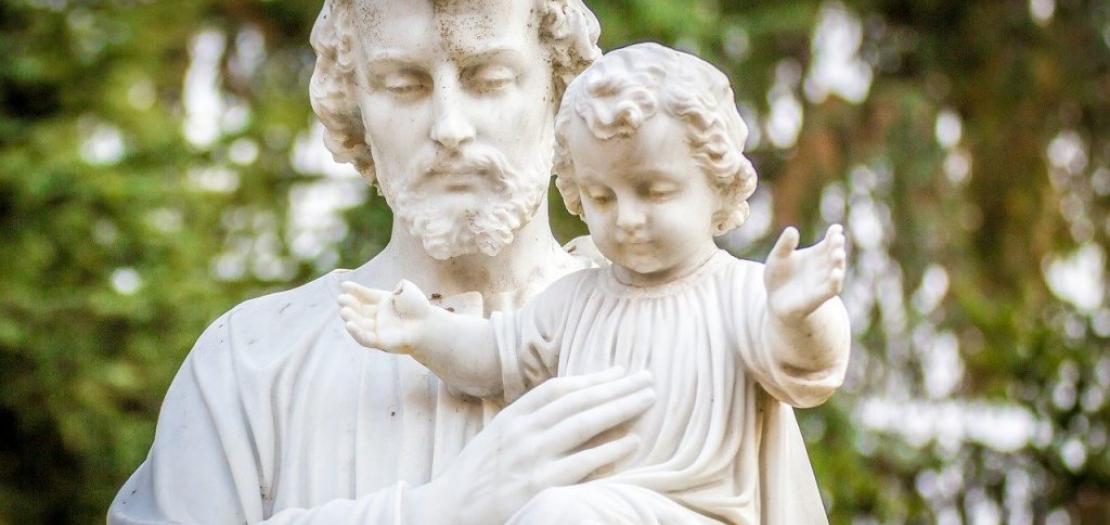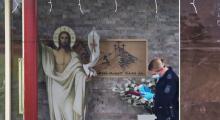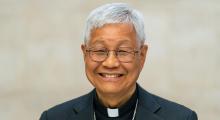Issued by the Catholic Center for Studies and Media - Jordan. Editor-in-chief Fr. Rif'at Bader - موقع أبونا abouna.org

Leonard J. DeLorenzo, Ph.D., is director of strategic planning, the Sullivan Family Saints Initiative, and undergraduate studies in the McGrath Institute for Church Life at the University of Notre Dame, where he also teaches in the Department of Theology. He spoke to Charles Camosy about his latest book, Model of Faith: Reflecting on the Litany of Saint Joseph.
Camosy: It is the year of St. Joseph, which I’m fairly certain is not accidental to your writing a book on the Litany of St. Joseph. But what else drew you to write a book like this?
DeLorenzo: In a previous book I wrote, I composed theological and spiritual reflections on 20 questions that Jesus asks in the Gospels (A God Who Questions, OSV). That was a refreshing and invigorating approach for me, because each reflection was its own brief chapter and the book invited readers to slow down to contemplate these Gospel scenes in depth and with creativity. That book was itself like a devotional work.
This new book on the Litany of Saint Joseph is not just “like” a devotional work –– it is a devotional work. The same publisher –– OSV –– asked me if I would be interested in helping people to reflect on and pray with this litany, and I jumped at the opportunity. For me as the author, I drew great spiritual nourishment from taking my time with one title or honor of Joseph at a time, and then writing a brief reflection for each one. In assembling reflections for each of the 22 titles and honors of Joseph in the Litany, I wanted to provide readers with the opportunity to settle into a deeper meditation on this great saint, while allowing their own imaginations and creativity to grasp his beauty in a new way.
In writing this book, I was responding to the Holy Father’s invitation to rededicate ourselves to Saint Joseph, the timely invitation from OSV, and my own love for taking a more devotional approach to reading and prayer.
I’ve being trying to pray the Litany of St. Joseph weekly – often with the help of YouTube, I’m embarrassed to say – during this year and I have to say I highly recommend it. For those who are interested in praying this prayer in a better and more informed way I also highly recommend reading your book.
What other strategies can you recommend, though, for developing the habit of praying the Litany of St. Joseph?
I think the most important thing is to slow down. Saint Joseph is a man of patience. He is a man of prudence. He waits upon the Word of God and then acts on it. By slowing down to pray this litany thoughtfully and intentionally, we not only allow ourselves to dwell with the mysteries that Joseph himself guarded, but we also practice becoming more like Joseph himself: patient, prudent, obedient.
I really like completing things. I really hate leaving things unfinished. This leads me to rush through books quite often, especially with a little book like this one. But I think the book itself can help us to develop a more heartfelt way of praying the Litany of Saint Joseph if we exercise the discipline to read one reflection at a time. By that, I mean that it would be a good practice to pray the Litany of Saint Joseph each day, then just one or maybe two of these chapters per day as a way to enrich our prayer and reflection. For someone like me, that approach heals me of the desire to rush towards completion. The key here is not completion but contemplation.
Speaking in terms of centuries, really strong devotion to St. Joseph is a relatively new thing in the Church, isn’t it? Why do you think such devotion has increased over time and is particularly strong in our day?
We know quite well that not a single word from Saint Joseph is recorded in Scripture. In that respect, he is a silent saint –– “the strong silent type” as people like to say. I’ve thought about this quite a bit and come to realize that there is a spiritual significance to this fact about Joseph. He does not draw attention to himself. Perhaps more than any other “well-known” saint, we need someone to introduce us to Joseph precisely because there is very little that would catch our attention otherwise. He doesn’t speak for himself. I wonder if the relatively new devotion to Saint Joseph has something to do with that: We have needed quite a bit of time for those who first discovered a love for Joseph to introduce the rest of us to this great saint.
Saint Teresa of Avila claimed Joseph as her special patron. Saint Andre Bessette prayed to Joseph constantly. Great saints like these know what is good for us. They are the ones who have drawn the rest of us in the Church (or maybe outside the Church) to entrusting our needs and concerns to the intercession of Saint Joseph.
I also think about the crisis of masculinity in our own day and age. Saint Joseph is certainly not just a saint for men, just like the Blessed Mother is not just a saint for women. But as the two options for masculinity in recent decades seem to be either toxic masculinity or the erasure of masculinity, Joseph shows us what a false dichotomy this is. It is a false choice. Here is a man who was tender enough to hold the tenderness of the Mother of God, and strong enough to protect the Holy Family, even against a bloodthirsty, small-time tyrant (the worst kind). Here is a man who confronted the most significant uncertainties with patience and did not act rashly, but when clarity dawned he did not hesitate to act decisively. Most of all, he did not seek to rule his own life or the lives of others. Instead, he was a servant and friend of God, trusting God to guide him. He is worthy of being a father to the fatherless and a friend to the lonely. His masculinity is neither threatening nor bland. He is bold and beautiful. We need that in our world today more than ever.
Okay, let’s dive into the book. Basically, each chapter focuses on a line from the Litany itself. “Faithful Guardian of Christ”, “Hope of the Sick”, etc. Did you have a particular chapter that surprised you when you dove into it? Or a chapter with an insight that really stuck out to you?
I was especially moved to contemplate Joseph as “Hope of the Sick.” Think about the times we have been living in. Haven’t we all been looking for more and more hope in the midst of growing sickness, and all its effects? Well, here is a saint who held in his arms the one who heals all ills. A woman once touched the fringe of Jesus’ garment and was healed of the sickness that had afflicted her for a dozen years. All she did was touch the robe. Now think about Joseph: he wasn’t just an inanimate piece of cloth that hung about Jesus; instead, he loved Jesus with a father’s love. He held him day after day as a child. He comforted him on hard times. He reassured him in the darkness. He cushioned Jesus as he slept. If that piece of cloth was an instrument of healing merely because it was touching Jesus, how much more will Joseph be an instrument of healing for all who are sick, for Joseph wrapped his arms around Jesus daily and showered him with fatherly devotion.
One of the more sobering and powerful lines from the Litany is “Patron of the Dying.” What wisdom and insight does this kind of devotion to St. Joseph offer a death-denying culture like ours?
There is a mural in the Basilica of the Sacred Heart on the campus of the University of Notre Dame that depicts Joseph on his deathbed, with Mary and Jesus tending to him on either side. That image is constantly before my eyes whenever I contemplate Joseph as “Patron of the Dying.”
Has anyone ever had more to be grateful for and more to mourn upon his own death than Saint Joseph? He alone was called upon to be a father to the Son of God and husband of the Mother of God. Alongside his wife, he poured his life into this child. He must have glowed with that special pride that only a parent can know when he has sacrificed time and again for love of his child, and he would not hesitate to do it all again a thousand times over. And yet, Joseph dies before he sees his beloved Jesus in full bloom, now his own man, going off to do his life’s work: his Fathers will. I think Joseph must have been full of gratitude and sorrow on his deathbed: gratitude for the gifts he had been given and the role he alone fulfilled, and sorrow for being parted from his son, his wife, and this life that he loved.
Joseph is the “Patron of the Dying” because he knows the beauty of a Christian death, which is found in both gratitude and sorrow. Both of those at the same time. Above all, though, Joseph knows and loves the one to whom we should direct our gratitude, and he always leads us to Him. And Joseph knows the one who joins us in our sorrow and will wipe every tear from our eyes, who has put an end to death. I think we all fear that, in the end, we die alone. But that image of Jesus and Mary holding Joseph on his deathbed shows us that even our death has been assumed in the mystery of the Incarnation. We can risk being both grateful and sorrowful because we are not alone. Christ takes on our death, the Blessed Mother prays for us at the hour of our death, and Joseph, who has been there, is himself a sign of our Christian hope.







